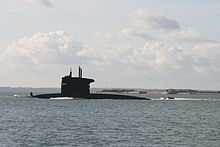Walrus class submarine
| The Dutch submarine Zeeleeuw, at SAIL Amsterdam 2005. | |
| Class overview | |
|---|---|
| Name: | Walrus class |
| Builders: | Rotterdamsche Droogdok Maatschappij |
| Operators: |
|
| Preceded by: | Zwaardvis class |
| In commission: | 1992- |
| Completed: | 4 |
| Active: | 4 |
| General characteristics | |
| Type: | Attack submarine |
| Displacement: | 2,350 t surfaced, 2,650 t submerged, 1,900 t standard |
| Length: | 67.73 m (222.2 ft) |
| Beam: | 8.4 m (28 ft) |
| Draft: | 6.6 m (22 ft) |
| Propulsion: | 3 diesels, diesel-electric, 5,430 shp (4 MW), 1 shaft, 5 blades |
| Speed: | 13 knots (24 km/h) surfaced, 20 knots (37 km/h) submerged |
| Range: | 18,500 km (10,000 nmi) at 9 kn (17 km/h) |
| Test depth: | >300 m (980 ft) |
| Complement: | 50 to 55 |
| Sensors and processing systems: | • Surface Search Radar:
• Sonar Systems:
|
| Armament: | |
The Walrus-class submarine is the only submarine class currently in operation in the Royal Netherlands Navy. They have been in service since 1990 and are all named after sea mammals.
Design
The Walrus-class submarines are unusual in that instead of a cross-shaped assembly of stern diving planes and rudders, they mount four combined rudders and diving planes in an "X" configuration. This tail configuration was first tested in 1960 on the United States Navy's USS Albacore, and has since been used by the Walrus class, all Swedish Navy submarines since the Sjöormen class, the Royal Australian Navy's Collins class, the German Type 212A and the Japan Maritime Self-Defense Force's Sōryū class.
The submarines were in high demand by NATO during the Cold War since they combined a highly skilled crew with a very silent boat. At that time the majority of NATO submarines were either nuclear or brown water subs, with the Walrus class being among the rare blue water diesel electric submarines in service.
Operational History
After the Cold War, the subs have been tasked for many highly confidential intelligence gathering operations (still classified) in the Yugoslavian region, Iran, Iraq and the Caribbean often on request of Allies, including the United States.
In June 2010, the Netherlands agreed to deploy one submarine to help combat piracy in the waters off Somalia.
Upgrade program
In 2007, the cabinet approved an upgrade of the four operational vessels and recruitment of additional crew to improve overall operational availability. The upgrades are focused on near-shore operations and integration with new weapons. These includes:
- the migration from the current MK 48 mod-4 torpedo to the mod-7 version
- replacing one periscope with a non-hull-penetrating optronic mast from L-3 KEO which enables the submarine to capture HD footage both day and night
- addition of a Mine & Obstacle Avoidance Sonar by ELAC Nautik
- refurbishing of the pressure hull
- introduction of a new combat management system
In November 2014 the Dutch Minister of Defence announced plans to replace the Walrus-class submarines[1] in 2025.
Boats
All boats were built by the Rotterdamsche Droogdok Maatschappij.
| Ship | Laid down | Launched | Commissioned | Fate |
|---|---|---|---|---|
| Walrus | 11 October 1979 | 28 October 1985 13 September 1989 (re-launched) |
25 March 1992 | In service |
| Zeeleeuw | 24 September 1981 | 20 June 1987 | 25 April 1990 | In service |
| Dolfijn | 12 June 1986 | 25 April 1990 | 29 January 1993 | In service |
| Bruinvis | 14 April 1988 | 25 April/May 1992 | 5 July 1994 | In service |
General characteristics
- Displacement: 2,350 t surfaced, 2,650 t submerged, 1,900 t standard
- Dimensions: 67.73 x 8.4 x 6.6 m
- Propulsion: 3 SEMT Pielstick 12PA4V200SM diesels, 1 Holec mainmotor, 1 shaft, 6 blades
- Speed: 13 knots surfaced, 20 knots submerged
- Complement: 50 to 55
- Surface Search Radar: DECCA 1229
- Sonar Systems: Thomson Sintra TSM 2272 Eledone Octopus, GEC Avionics Type 2026 towed array, Thomson Sintra DUUX 5B passive ranging and intercept
- Fire Control: HSA SEWACO VIII action data automation, GTHW integrated Harpoon and torpedo FCS
- Armament: 4 x 21 inch (533mm) torpedo tubes (20 Honeywell Mk 48 or Honeywell NT 37 torpedoes, mines, SubHarpoon SSM)
Images
-

HNLMS Dolfijn and escort approaching Portsmouth Naval Base, UK, 19 Nov 2009 in poor weather.
-

HNLMS Dolfijn departing Portsmouth Naval Base, UK, 1 Feb 2010.
-

HNLMS Dolfijn heading to sea from Portsmouth Naval Base, UK, 1 Feb 2010.
References
- ↑ Tomkins, Richard (22 January 2015). "Swedes, Dutch partner for future submarine work". UPI.com. Retrieved 3 March 2015.
External links
| Wikimedia Commons has media related to Walrus class submarines. |
| ||||||||||||||||||||||||||||||||||||||||||